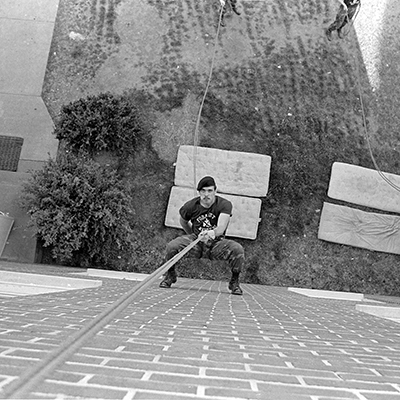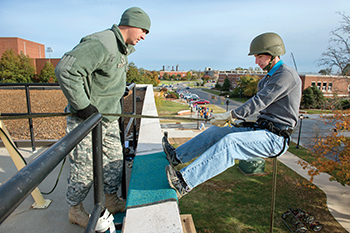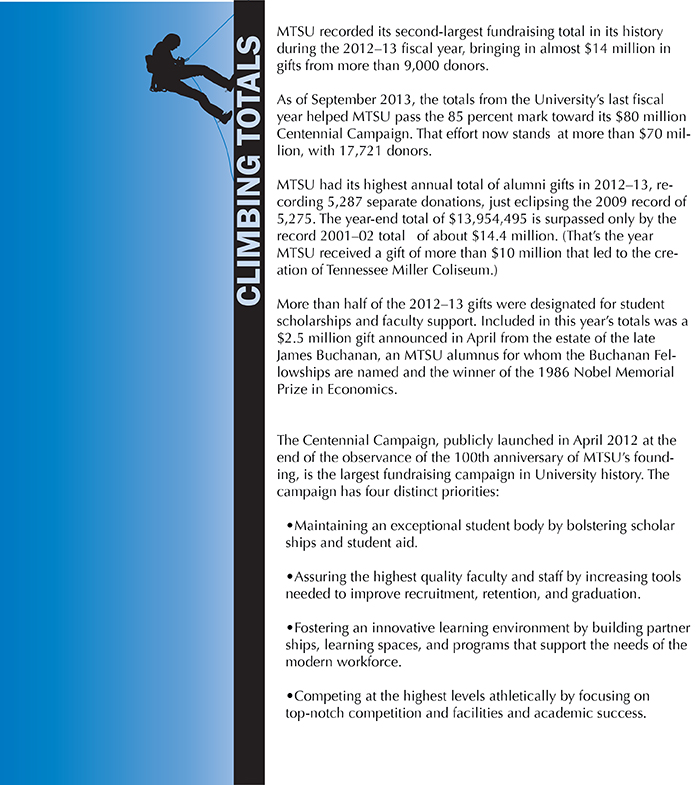
Generous alumni provide a lift to current and future ROTC cadets
By Bill Lewis
John Harris can’t count the number of times he stood on the roof of Forrest Hall and stepped off into empty space, supported by only a rope and his confidence in his fellow ROTC cadets. Visiting campus four decades later, he was astonished to see students still doing the same thing.
“I saw the kids rappelling off the building 40 years later and said, ‘You’ve got to be kidding me,’” says Harris, who as an undergraduate was a member of the Blue Raider Battalion and went on to an eventful Army career that included service in Saudi Arabia and Kuwait during Operation Desert Storm. He retired as a lieutenant colonel.
When he returned to campus, Harris, a member of the class of 1974, found the answer to the question that led him to MTSU that day. Having recently sold the technology business he cofounded in Hawaii after leaving the Army, he was looking for a way to give something back.
“MTSU helped me grow up and become who I am,” he says. “It certainly set me on a path, [providing] a solid foundation to get started with.”
Gifts from Harris and other donors allowed MTSU to break ground on its first-ever freestanding rappelling tower. To be located near the softball fields and the Recreation Center on the burgeoning east side of campus, the tower was under construction at press time.
The Tennessee National Guard also made a contribution, providing manpower for construction of the 10-foot security fence around the site of the tower and an obstacle course that is expected to be added in the future.
The tower is more than just a structure, says Lt. Col. Joel Miller, professor of military science. For the cadets who train there, it will help build pride and confidence.
“The big piece is confidence in themselves, their equipment, and their superior, [as well as] the development of esprit de corps and morale,” Miller says.

Model of the type of tower Cornerstone Designs of Asheville, North Carolina, is building on campus
Rappelling is one of the crucial first steps in the development of young officers. Generations of cadets in the Blue Raider Battalion learned those lessons at Forrest Hall. They include the top officer in the Tennessee National Guard, Major General Max Haston.
Walking across campus one day in 1975, Haston noticed cadets rappelling off the building.
“The next thing I knew, I was enrolled the next semester,” Haston says. “I have never looked back and still believe it was a life-changing decision. I have never regretted being part of ROTC as the military became my life’s direction.”
He sees the Guard’s assistance with the project as something greater than building a fence. It is an investment in the future of ROTC at MTSU and the future of the military itself.
The service academies—the U.S. Military Academy at West Point, the Air Force Academy in Colorado, and the Navy Academy at Annapolis—can’t possibly produce enough officers for the military. The armed forces depend on ROTC programs at MTSU and other schools for a steady stream of future leaders.
“We must maintain a strong ROTC program to ensure quality [and] balanced leadership,” Haston says.
The lessons cadets learn at Forrest Hall are timeless, but warfare and the way soldiers train for it have changed over the decades. The limited experience of rappelling off the roof of a two-story building can’t prepare cadets for real-world situations—which include rappelling from upper-story windows and from helicopters.
“Soldiers have operations that are different from going off the side of a building,” says Joe Lackey, whose company, Asheville, N.C.-based Cornerstone Designs Inc., was selected to build the rappelling tower.

Forrest Ranger cadet JB Burton rappels off the side of Forrest Hall in 1981
The 52-foot-high wooden structure will be a landmark on campus. Its highest rappelling station, 44 feet off the ground, will be twice as high as Forrest Hall. Its cantilevered top deck—with no footholds, just air, below—will allow cadets to simulate the experience of rappelling out of a helicopter. Exits on multiple levels will provide the experience of leaping from a window or doorway.
The tower will also provide areas for Blue Raider cadets to gather their equipment and conduct safety checks. It also has another advantage over Forrest Hall, where everybody had to rappel from the roof whether it was their one hundredth experience or their first.
The planned tower features a “beginner’s platform” about 10 or 12 feet off the ground, he says. Beginners can gain experience before climbing the stairs and stepping off the top deck.
“The first step is a big one,” Lackey says. “It takes someone who knows nothing and helps them progress.”
The rappelling tower will be used solely by the roughly 120 students studying military science. Any student can participate in the basic ROTC program for two years without making a commitment to serve in the Army. Students who choose to pursue a commission can become “contracted” cadets and participate in the program for their junior and senior years.
The Blue Raider Battalion has produced officers who serve in the Tennessee National Guard, the Army Reserves, and in the Army on active duty. Seventeen alumni of the battalion have risen to the rank of general since the founding of MTSU’s ROTC program in 1950, earning the University the nickname “cradle of generals.”
That count includes Army officers who were members of the Blue Raider Battalion. It doesn’t include MTSU graduates who have risen to the rank of general in the Air Force and Marines or to admiral in the Navy.
“For sure, MTSU has produced better than its fair share of general officers,” Haston says. “The pro rata share of generals produced compared to the years the ROTC department has been in operation places MTSU as one of the top-producing schools [of general officers].”

SFC Frederick Greenwell instructing Graham Hutcheson rapelling at Forrest Hall in 2012
Harris, whose contribution, along with those of other alumni and families of cadets, made the rappelling tower a reality, didn’t arrive on campus with dreams of military glory. A defensive end on the Blue Raider football team, he was dreaming of the NFL.
ROTC was a required course for freshmen and sophomores at the time, so Harris quickly found himself standing on the roof of Forrest Hall. Becoming a contracted cadet for his junior and senior years meant he received a small monthly stipend of about $100 and something priceless—an exemption from the draft at the height of the war in Vietnam.
“In my effort to stay out of the Army, I spent 20 years in the Army,” says Harris, who served in the Medical Service Corps and in Desert Storm, on behalf of the Army Surgeon General, where he helped the Army deploy modern field hospitals, replacing MASH-style hospitals with modern facilities.
“Fortunately, we didn’t need most of those hospitals,” he says. Desert Storm had few casualties and was “nothing like what the kids are going through today.”
After retiring, Harris and two Army buddies founded Akimeka, an IT services and software development company. (The name is Hawaiian and means “perseverance.”)
They sold the company a few years ago to a publicly traded company. Harris, who lives in the Orlando area, began looking for ways to give back to the University.
“What better place is there to give back than where your roots are?” he says.
He plans to return to campus for the rappelling tower’s dedication. But Harris, a qualified parachutist whose souvenirs of military service include knee replacements and back surgeries, has no plans to try out the tower firsthand.
“Absolutely not,” he says. “But the dedication is on my calendar.”



COMMENTS ARE OFF THIS POST